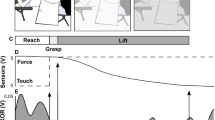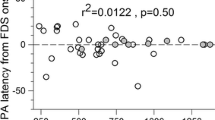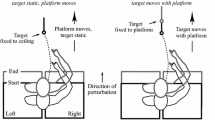Abstract
During goal-directed arm movements, the eyes, head, and arm are coordinated to look at and reach the target. We examined whether the expectancy of visual information about the target modifies Anticipatory Postural Adjustments (APAs). Ten standing subjects had to (1) move the eyes, head and arm, so as to reach, with both gaze and index-finger, a target of known position placed outside their visual field (Gaze-Reach); (2) look at the target while reaching it (Reach in Full Vision); (3) keep the gaze away until having touched it (Reach then Gaze) and (4) just Gaze without Reach the target. We recorded eye, head, right arm, and acromion kinematics, EMGs from upper- and lower-limb muscles, and forces exerted on the ground. In Gaze-Reach, two coordination strategies were found: when gaze preceded arm muscle recruitment (Gaze-first) and when the opposite occurred (Reach-first). APAs in acromion kinematics, leg muscles, and ground forces started significantly earlier in Gaze-first vs. Reach-first (mean time advance: 44.3 ± 8.9 ms), as it was in Reach in Full Vision vs. Reach then Gaze (39.5 ± 7.9 ms). The Gaze-first to Reach-first time-shift was similar to that between Reach in Full Vision and Reach then Gaze (p = 0.58). Moreover, Gaze without Reach data witnessed that the head-induced postural actions did not affect the APA onset in Gaze-first and Reach-first. In conclusion, in Gaze-first, the central control of posture considers visual information while planning the movement, like in Reach in Full Vision; while Reach-first is more similar to Reach then Gaze, where vision is not required.





Similar content being viewed by others
References
Aruin AS, Shiratori T (2004) The effect of the amplitude of motor action on anticipatory postural adjustments. J Electromyogr Kinesiol 14:455–462
Bouisset S, Do MC (2008) Posture, dynamic stability, and voluntary movement. Neurophysiol Clin 38:345–362
Bruttini C, Esposti R, Bolzoni F, Cavallari P (2014) Ischemic block of the forearm abolishes finger movements but not their associated anticipatory postural adjustments. Exp Brain Res 232:1739–1750
Bruttini C, Esposti R, Bolzoni F, Vanotti A, Mariotti C, Cavallari P (2015) Temporal disruption of upper-limb anticipatory postural adjustments in cerebellar ataxic patients. Exp Brain Res 233:197–203
Carnahan H, Marteniuk RG (1991) The temporal organization of hand, eye, and head movements during reaching and pointing. J Mot Behav 23:109–119
Caronni A, Bolzoni F, Esposti R, Bruttini C, Cavallari P (2013) Accuracy of pointing movements relies upon a specific tuning between APAs and prime mover activation. Acta Physiol 208:111–124
Commissaris DA, Toussaint HM, Hirschfeld H (2001) Anticipatory postural adjustments in a bimanual, whole-body lifting task seem not only aimed at minimising anterior-posterior centre of mass displacements. Gait Posture 14:44–55
Enright JT (1995) The non-visual impact of eye orientation on eye-hand coordination. Vision Res 35:1611–1618
Esposti R, Bruttini C, Bolzoni F, Cavallari P (2015) Intended rather than actual movement velocity determines the latency of anticipatory postural adjustments. Exp Brain Res 233:397–403
Frens MA, Erkelens CJ (1991) Coordination of hand movements and saccades: evidence for a common and a separate pathway. Exp Brain Res 85:682–690
Gonzalez DA, Kegel S, Ishikura T, Lee T (2012) Effects of vision on head-putter coordination in golf. Motor Control 16:371–385
Gopal A, Murthy A (2015) Eye-hand coordination during a double-step task: evidence for a common stochastic accumulator. J Neurophysiol 114:1438–1454
Heath M (2005) Role of limb and target vision in the online control of memory-guided reaches. Motor Control 9:281–311
Hollands MA, Marple-Horvat DE (1996) Visually guided stepping under conditions of step cycle-related denial of visual information. Exp Brain Res 109:343–356
Horak FB, Esselman P, Anderson ME, Lynch MK (1984) The effects of movement velocity, mass displaced, and task certainty on associated postural adjustments made by normal and hemiplegic individuals. J Neurol Neurosurg Psychiatry 47:1020–1028
Krigolson OE, Heinekey H, Kent CM, Handy TC (2012) Cognitive load impacts error evaluation within medial-frontal cortex. Brain Res 1430:62–67
Krishnan V, Aruin AS (2011) Postural control in response to a perturbation: role of vision and additional support. Exp Brain Res 212:385–397
Lee WA, Buchanan TS, Rogers MW (1987) Effects of arm acceleration and behavioral conditions on the organization of postural adjustments during arm flexion. Exp Brain Res 66:257–270
Lee WA, Michaels CF, Pai YC (1990) The organization of torque and EMG activity during bilateral handle pulls by standing humans. Exp Brain Res 82:304–314
Leonard JA, Brown RH, Stapley PJ (2009) Reaching to multiple targets when standing: the spatial organization of feedforward postural adjustments. J Neurophysiol 101:2120–2133
Lin SI, Yang WC (2011) Effect of plantar desensitization on postural adjustments prior to step initiation. Gait Posture 34:451–456
Massion J (1992) Movement, posture and equilibrium: interaction and coordination. Prog Neurobiol 38:35–56
Miall RC, Reckess GZ, Imamizu H (2001) The cerebellum coordinates eye and hand tracking movements. Nat Neurosci 4:638–644
Mohapatra S, Aruin AS (2013) Static and dynamic visual cues in feed-forward postural control. Exp Brain Res 224:25–34
Mohapatra S, Krishnan V, Aruin AS (2012) The effect of decreased visual acuity on control of posture. Clin Neurophysiol 123:173–182
Pozzo T, Ouamer M, Gentil C (2001) Simulating mechanical consequences of voluntary movement upon whole-body equilibrium: the arm-raising paradigm revisited. Biol Cybern 85:39–49
Reed-Jones R, Reed-Jones J, Vallis LA, Hollands M (2009) The effects of constraining eye movements on visually evoked steering responses during walking in a virtual environment. Exp Brain Res 197:357–367
Shiratori T, Aruin A (2007) Modulation of anticipatory postural adjustments associated with unloading perturbation: effect of characteristics of a motor action. Exp Brain Res 178:206–215
Stapley PJ, Pozzo T, Cheron G, Grishin A (1999) Does the coordination between posture and movement during human whole-body reaching ensure center of mass stabilization? Exp Brain Res 129:134–146
Wilson M, Stephenson S, Chattington M, Marple-Horvat DE (2007) Eye movements coordinated with steering benefit performance even when vision is denied. Exp Brain Res 176:397–412
Ypsilanti A, Hatzitaki V, Grouios G (2009) Lateralized effects of hand and eye on anticipatory postural adjustments in visually guided aiming movements. Neurosci Lett 462:121–124
Author information
Authors and Affiliations
Corresponding author
Ethics declarations
Funding
This study was supported by a “Fondo di Investimento per la Ricerca 2014” Grant from the “Università degli Studi di Milano”, Italy.
Conflict of interest
The authors declare that they have no conflict of interest.
Rights and permissions
About this article
Cite this article
Esposti, R., Bruttini, C., Bolzoni, F. et al. Anticipatory Postural Adjustments associated with reaching movements are programmed according to the availability of visual information. Exp Brain Res 235, 1349–1360 (2017). https://doi.org/10.1007/s00221-017-4898-3
Received:
Accepted:
Published:
Issue Date:
DOI: https://doi.org/10.1007/s00221-017-4898-3




